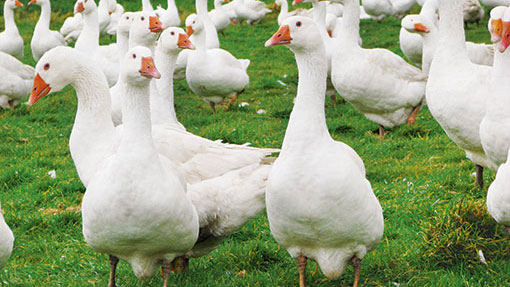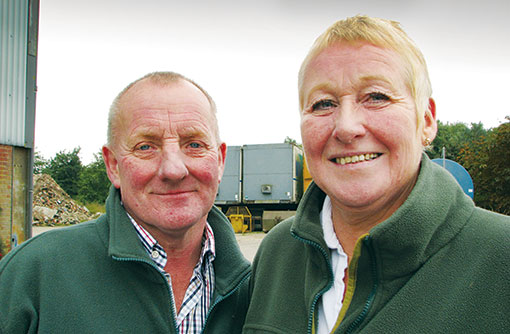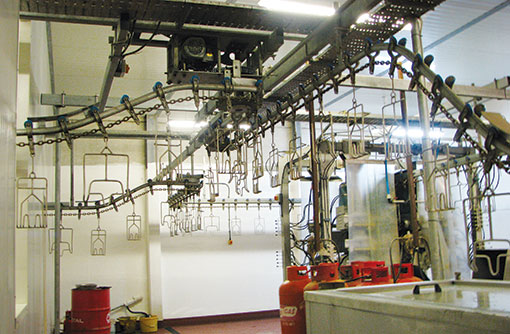Ducks and geese – a watertight business

A family business in East Yorkshire which specialises in the production of ducks and geese played host to the annual British Goose Producers’ farm walk. Wendy Short joined in
More than £300,000 has been invested in processing facilities at Southfield.
Southfield Farm, near Beverley, is a 142ha (350 acre) mainly arable holding, with about 16ha (40 acres) of permanent grass used for free-range poultry, sold under the brand name Yorkshire Ducks and Geese.
Four family members are involved in the business, with Stuart and Ruth Mathison looking after the poultry side. Poultry have been part of Southfield since the early 1970s, but the birds were not reared in any significant numbers until a decade ago.
Up until 2007, the Mathisons took all their birds to one wholesale customer for processing and then bought a percentage back, for selling direct to local restaurants, hotels and butchers.
However a change in the law forced the family to re-think the marketing strategy.
“Our wholesaler had been processing a variety of poultrymeat, but the new ruling stated that, if chickens were going through the system, then other species could not be processed alongside them,” explains Mr Mathison.
“We had been rearing about 1,000 geese annually and a similar number of ducks. At that point, we decided to make a firm commitment to poultry and take more control of the enterprise, by installing our own processing plant.”

Processing
To date, the family’s investment in the new plant, which is housed in a building measuring 60m x 30m, has topped £300,000. Further improvements, projected to cost about £75,000, are in the pipeline.
It is capable of handling 300 geese a day and about 350 ducks within four hours and includes a waxing facility, for prolonged shelf-life.
Some 2,000 fresh geese and several thousand fresh ducks – all reared from day old – are sold all year round, with goose sales hitting a peak in the run-up to Christmas.
During this period, the family also markets pheasant and partridge from a local estate.
There are no permanent members of staff at Southfield, but casual workers are brought in during peak processing times.
Bird management
When the family first started producing geese, the birds were bought at a local market, but these proved very difficult to finish.
Legarth geese were much more successful, but the Mathisons also tested a strain of bird imported from Germany. As both groups are equally satisfactory, they have stuck with this “half and half” arrangement.
Young goslings start on chick crumbs and when they are first turned out, grass is their staple diet. As the finishing period approaches, they are offered home-produced wheat and a 4% protein grower pellet, to reach a slaughter weight of 4-6kg.
“Our aim is to use grass to put a big frame on the geese and then supplementary feed towards finishing,” says Mr Mathison.
“A bird with a small frame will never reach the weights that we need, to supply the type of product that our customers are looking for.”
Duck production is far less seasonal and about 650 day-old ducklings are delivered every fortnight. These are kept in a heated indoor building on chopped straw for a further two-to-three weeks, or longer if the weather is wet and cold.
A simple outdoor fencing system, which uses pig netting, keeps the birds within the boundaries of the five paddocks.
At night, they are housed in wooden sheds made of Yorkshire boarding, to encourage air flow, while feed is put into plastic pig hoppers, purchased second-hand.
Despite the rapid growth rates which can be achieved, the free-range poultry remain healthy and their legs are strong, a feature which Mr Mathison attributes to the exercise they get through being outdoors.
All free-range poultry producers share a common enemy; the fox. Mr Mathison vigorously defends his birds by night shooting, using a dead bird as a decoy.
“This policy is very effective; if foxes get out of control, they will start coming in the day time and that indicates a serious problem.
“For the first time last spring, I have lost a few young ducks to a barn owl. I put this down to the cold snap, which reduced the number of small rodents available.”
The aim is for ducks to average 3.5-4kg/head, as the festive season approaches.
For the rest of the year the birds, which are a hybrid of the Aylesbury and Pekin breeds, are taken to about 2.5kg at finishing, a process which takes approximately seven weeks.
Marketing ducks
Demand for duck has been boosted since the introduction of portion-controlled products. These appeal to restaurant chefs, as they offer a clear and precise margin, says Mr Mathison.
He feels it is vital that his prices remain competitive, in order to both attract and retain his customers.
Farmers’ markets have been a lifeline to a wide variety of farm businesses trying to increase their market share by selling direct and the Mathisons are no exception. Mrs Mathison attends several of these events on a regular basis, having invested in a market stall and a refrigerated van, which is also used for direct deliveries.
In general, restaurants are looking for duck breasts and legs and not the whole carcass, comments Mr Mathison.
Originally, he found it difficult to market the less-expensive cuts, as well as the offal. However, a visit to an oriental restaurant solved that problem.
“They were very keen to take offal, including livers, as well as the feet and necks of the birds. I have since added several other Chinese restaurants to my round, although I’m not sure exactly how they use the meat.”
Mr Mathison admits that the sales side of the business did not come naturally to him at first, but he has grown in confidence since he became involved in sourcing new customers.
“I found cold calling quite difficult to start with, but I’m used to it now and actually I quite enjoy it. What seems to work is giving restaurants and hotels a couple of birds free of charge, and then following up with a phone call, to see whether they would like to place an order.
“Once they have tried it, most of them will buy regularly; they are all looking for something a bit different, and the fact that it is free-range ticks the welfare box.”

Future plans
“Our future plan is to expand gradually; ideally, we would like to produce 1,000 ducks each week and another 1,000 geese for Christmas, although we’re not sure the time is right for any major increase in production, because of the economic climate.
“Matching supply and demand is not easy and with larger flocks, we may need to take another look at selling birds wholesale. But for now, we are satisfied with the way things have developed; poultry fits in well with arable farming and we have a steady stream of new customers. It would be wrong to describe it as a ‘get-rich-quick’ business, but I would say we are making steady progress.”
The family won runner-up with their duck breast in a East Riding Food Group contest in 2013.
Stuart and Ruth Mathison have built a year-round trade in ducks, with geese peaking seasonally.
| British Goose Producers’ marketing campaign: Putting goosemeat on the menu |
|---|
| The British Goose Producers, a sector group of the British Poultry Council, is running a campaign to promote the use of goosemeat out of season. The organisation is working with staff and students at City College Norwich where hotel school students are experimenting with a number of recipes, which also include goose eggs. The Mathisons themselves supply goose to the Tickton Grange country hotel, in neighbouring Beverley, where chef David Nowell is enthusiastic about the product. One of his recipes involves cooking the bird in a water bath, to avoid the shrinkage which can occur during more traditional methods of cooking. Another favourite is a roulade of goose breast, served with a mousseline of goose liver, thyme, hazelnut and cranberries. The Mathisons have been working hard to encourage their catering clients to put goose on the menu outside the traditional season. Birds are also sold to individual customers, who call in at the farm after seeing the sign at the entrance. |
(More poultry industry news)
